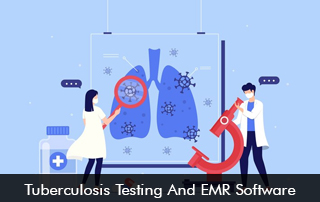Tuberculosis (TB) remains a significant global health challenge, with millions of cases reported annually. Despite advancements in healthcare, TB diagnosis and management remain complex. However, EMR software has revolutionized healthcare delivery, including TB testing and management. This blog explores the significance of TB testing, the challenges involved, and how EMR software facilitates efficient diagnosis and treatment.
Understanding Tuberculosis Testing
Tuberculosis is an infectious disease caused by the bacterium Mycobacterium tuberculosis. It primarily affects the lungs but can also affect other parts of the body. TB spreads through the air when an infected person coughs or sneezes, making it highly contagious. Prompt diagnosis is crucial to prevent transmission and initiate timely treatment.
TB testing involves various methods, including:
- Tuberculin Skin Test (TST): Also known as the Mantoux test, this involves injecting a small amount of tuberculin under the skin and assessing the reaction after 48-72 hours.
- Interferon-Gamma Release Assays (IGRAs): These blood tests detect the release of interferon-gamma in response to TB antigens, providing a more specific alternative to the TST.
- Chest X-rays: Imaging tests help identify abnormalities in the lungs suggestive of TB, such as cavities or infiltrates.
- Molecular Tests: Polymerase chain reaction (PCR) tests detect TB DNA in sputum samples, offering rapid and accurate diagnosis.
Challenges in TB Testing
Despite the availability of diagnostic tools, TB testing faces several challenges:
- Limited Access to Healthcare: In many regions, particularly low-income countries, access to healthcare facilities and diagnostic tests is limited, leading to underdiagnosis and inadequate treatment.
- Stigma and Fear: TB is associated with stigma and discrimination, leading to reluctance among individuals to seek testing and treatment, further exacerbating the spread of the disease.
- Diagnostic Delays: Traditional TB tests such as sputum microscopy require time-consuming laboratory procedures, leading to delays in diagnosis and treatment initiation.
- Data Management Issues: Managing TB patient data, including test results, treatment regimens, and follow-up appointments, can be challenging, especially in settings with limited resources.
The Role of EMR Software in TB Testing
Electronic Medical Record (EMR) software plays a pivotal role in streamlining TB testing and management:
Centralized Patient Data
EMR consolidates patient information, including demographic data, medical history, and test results, in a centralized database accessible to healthcare providers. This facilitates quick retrieval of TB-related information, enabling timely diagnosis and treatment.
Integration of Diagnostic EMR Software Tools
EMR software can integrate with laboratory information systems, allowing seamless transmission of TB test results directly into the patient’s electronic record. This reduces the risk of data entry errors and expedites result interpretation.
EMR Software Decision Support Tools
EMR systems equipped with decision support tools offer clinical guidance to healthcare providers during TB diagnosis and treatment. These tools may include algorithms for interpreting test results, recommending appropriate treatment regimens based on drug sensitivity patterns, and reminding providers of follow-up appointments.
Surveillance and Reporting
EMR software enables real-time surveillance of TB cases, helping public health authorities monitor disease trends, identify outbreaks, and allocate resources effectively. Moreover, automated reporting functionalities streamline the process of notifying relevant authorities about newly diagnosed TB cases, as required by public health regulations.
EMR Software Telemedicine Capabilities
In regions with limited access to healthcare facilities, EMR software with telemedicine capabilities enables remote consultation and monitoring of TB patients. This facilitates adherence to treatment regimens and reduces the need for frequent in-person visits, particularly for patients residing in remote areas.








